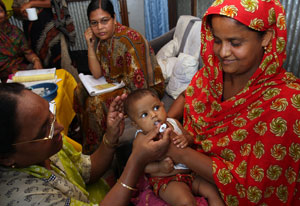New Indian rotavirus vaccine provides hope
May / June 2013 | Volume 12, Issue 3
Opinion by Dr. Roger I. Glass
Director, Fogarty International Center
Science advances certainly require good ideas, hard work and perseverance. But I've found serendipity, personal relationships and good partnerships can also play a significant role.
In 1985, I traveled to Calcutta for a WHO meeting on diarrheal diseases, where I met a young Indian pediatrics professor, Dr. Maharaj "Raj" K. Bhan. Since we were housed at a convent with strict rules forbidding alcohol, we decided to leave the premises together for a drink. Our casual conversation that night spawned nearly three decades of fruitful collaboration. This May, it's my pleasure to join Raj and our now many other partners in New Delhi to review the
results of a clinical trial of an affordable and effective rotavirus vaccine that is the result of this unplanned meeting 28 years ago.
During that long-ago happy hour, Raj mentioned he was following a rotavirus outbreak in the newborn unit at the All India Institute of Medical Sciences (AIIMS). He noted it was surprising the infected neonates didn't develop diarrhea. At the time, I was working on an NIH effort studying an unusual group of rotaviruses collected from newborns on four continents that also did not cause the disease. And so began our joint efforts to see if these infections could protect children against subsequent severe rotavirus disease.

Photo courtesy of PATH
A new vaccine will help to reduce the impact of rotavirus
in India. Eighty percent of Indian children are infected in
the first year of life with 1 fatality per 200 children.
After three years of informal collaboration, the
Indo-U.S. Vaccine Action Program (VAP) was launched by the Indian Department of Biotechnology and NIH's National Institute of Allergy and Infectious Diseases (NIAID) and our project was approved for funding. Further study of the AIIMS strain of rotavirus indicated it was safe in adults and that it might be a good candidate for a vaccine for children. In 1998, a meeting organized by VAP brought investigators together with a group of Indian vaccine manufactures, including Dr. Krishna Ella, CEO of Bharat Biotech. His enthusiasm was infectious and we began the vaccine development process.
There have been bumps along the road and many wonderful partners joined the project - most importantly the Gates Foundation and program at
PATH. By 2011 we were finally ready to launch a trial with 6,800 infants at three sites in India conducted by an NGO, the Society for Applied Studies, that grew out of the need for larger field trials. Thankfully, the results have been positive. We hope the vaccine will be licensed so that it can be introduced in several sites in India. We're confident this will make a huge impact and go a long way to preventing the 100,000 rotavirus deaths that currently occur in that country every year.
We've accrued other benefits during this long and winding journey. As we studied the epidemiology of rotavirus in India, we discovered vast differences in the epidemiology of disease between low- and high-income settings. We learned there are more diverse rotavirus strains circulating in India at any time than anywhere else in the world and that Indian children are more likely to be infected with several strains rather than a single strain. While rotavirus infections are highly seasonal in the U.S. and Europe, they occur year-round in India. Eighty percent of Indian children are infected in the first year of life with fatalities occurring for about 1 in 200.
Through our many years of partnership, we also provided more than a dozen investigators and young scientists with significant research training, which has prepared them to tackle other remaining health challenges.
Finally, it's significant that this new vaccine was derived from an Indian strain, identified by an Indian scientist, developed by an Indian company, studied in Indian populations, with support from the Indian government. It's likely the first entirely new vaccine developed in India in over 100 years! There is still much to be done to take this vaccine to India's children - but I am encouraged this will have an immediate and considerable impact on reducing the global burden of rotavirus.
More Information
-
Newly published study indicates lifesaving potential for new rotavirus vaccine
PATH announcement, March 12, 2014
-
ROTAVAC clinical trial results news release, fact sheets and media statements from PATH project site
defeatDD.org, May 14, 2013 -
Development of Candidate Rotavirus Vaccines Derived from Neonatal Strains in India
Journal of Infectious Diseases, 2005:192 -
Indian scientists see cheap rotavirus vaccine as start of homegrown drug industry
Deutsche Welle (DW), May 24, 2013 -
The making of Rotavac
Livemint.com, May 20, 2013 -
India clears path for new, more affordable rotavirus vaccine
GlobalPost, May 17, 2013 -
India develops new vaccine against diarrhoea [Video]
New Delhi Television (NDTV), May 14, 2013 -
Results of the ROTAVAC Rotavirus Vaccine Study in India
Statement of Anthony S. Fauci, M.D., Director, National Institute of Allergy and Infectious Diseases, May 14, 2013 - Background:
The Neonatal Rotavirus Vaccine Project (Strain 116E) Rotavac: A Brief Review for the 25th Anniversary of the Indo-US Vaccine Action Program (VAP) by Fogarty Director Dr Roger I Glass
- Access information on the
PATH live rotavirus vaccine develompent program.
To view Adobe PDF files,
download current, free accessible plug-ins from Adobe's website.